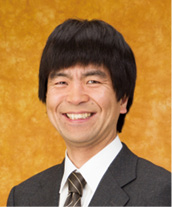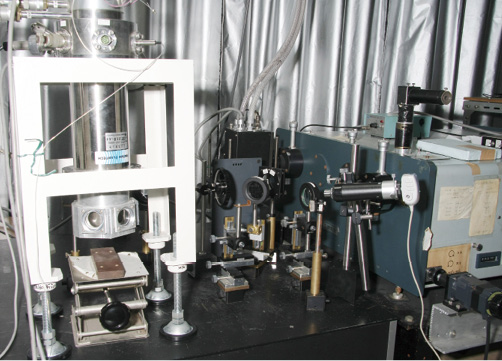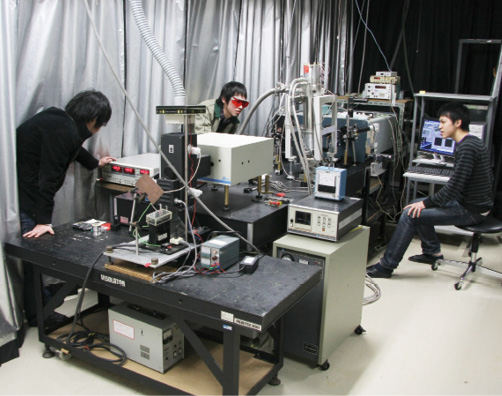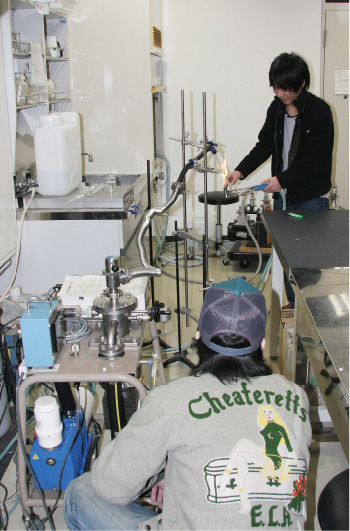
As of August, 2015
| Faculty/Department | Department of Engineering Science Graduate School of Informatics and Engineering |

|
| Members | Tsuyoshi Okuno, Associate professor | |
| Affiliations | Physical Society of Japan; Japan Society of Applied Physics; Phosphor Research Society | |
| Website | http://www.tcc.pc.uec.ac.jp/ | |
Optical physics, nanotechnology, high-intensity light emission, silicon photonics
At our laboratory, we are creating semiconductors characterized by unique nanostructures. In this way, we hope to advance the exploration, elucidation, and application of their novel optical functions. Most semiconductors are made from silicon.
Fortunately for the semiconductor industry, silicon is the second most abundant element on earth. However, it has one great disadvantage: It does not emit light. Our laboratory has embarked on research to make silicon emit light and to create light-emitting semiconductors and light-emitting silicon wafers.
Finding a way to make silicon itself emit light would eliminate the need to use other light-emitting components, such as light-emitting diodes (LEDs), making it possible to place both the light-emitting component and its drive circuit within a single integrated circuit to achieve low power consumption, low cost, and high volume data transmission. Researchers around the globe are currently pursuing research to produce a light-emitting silicon, and this quest has become one of the major areas of semiconductor technology research.
Some of the techniques devised to date involve depositing a light-emitting thin film on silicon surfaces. Others involve nanostructured materials that emit light. The approach currently being taken at our laboratory involves doping silicon nanostructure with light-emitting elements. This has met with some success; we have achieved luminous efficacy of 2%.
We have confirmed that the europium (Eu)-doped silicon made in our laboratory emits light in the yellow range.
We believe the most effective application is to create light-emitting silicon that can be connected directly to optical fibers. This requires the emission of light at a wavelength of 1.5 μm.
Working vigorously to identify the factors leading to high-intensity light emission and to create such silicon, we are analyzing our newly developed semiconductor materials using various apparatus including X-ray diffractometers, elemental analyzers, and electron microscopes.
Technologies in high-resolution spectroscopy make it possible to perform structural analysis using physical phenomena such as crystal vibration. By accumulating the results of studies employing various material analysis and evaluation methods, we believe we can discover and produce new materials.
We have already completed joint research projects involving our technologies with commercial enterprises.
We plan to explore nanostructures and other unique structures in materials other than silicon to uncover and gain an understanding of new and more useful luminescence phenomena.
We were able to grow a nano-sized “needles” of zinc oxide, a safe, white, and inexpensive material commonly used in cosmetics. These needles exhibit strong emission of red light.
Since zinc oxide has been known to emit blue and green light, we may eventually be able to develop a diode produced from a single material that can emit light of all colors.
It is worth noting that “creating a light-emitting silicon” is equivalent to “creating a light-emitting diode with silicon.” Success in this endeavor would create a revolutionary technology with immense potential, one capable of changing how diodes are applied across industry, just as LEDs changed lighting technologies. Our laboratory will continue to devote its best efforts to this area to bring about this change.




